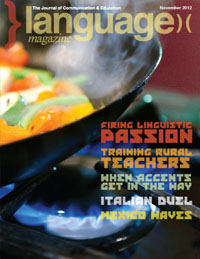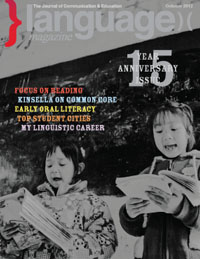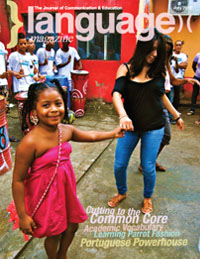Kristal Bivona explores the natural and cultural diversity of Brazil
Wake up and smell the cafezinho. The world is finally recognizing that Brazil is half of Latin America and potentially the next world superpower. Students are looking to learn Portuguese to either compliment their Spanish and Latin American studies, or simply because there has never been a more exciting time to study the Portuguese language in one of the world’s most diverse countries. Brazil’s indigenous populations, its participation in the African slave trade, and its complex relationship with Portugal (Rio de Janeiro was the seat of the Portuguese Empire for 13 years) have created a truly multicultural society.
Brazil is a giant nation, about the size of the continental U.S., divided into five distinct regions.
The North
The north captured the imaginations of Claude Levi-Strauss and other linguists who flocked to the Amazon region to study its rare indigenous languages. The heart of the Amazon rainforest, northern Brazil also boasts interesting cities, such as Manaus and Belém do Pará, both of which depend on the network of rivers that zigzag through the Amazon basin and offer delicacies, flora, and fauna that are unique to the region. The north is an ideal destination for students interested in the life sciences, indigenous studies, conservation, and the environment.
The Northeast
The northeast is famous for a vibrant Afro-Brazilian culture and is home to some of the nation’s most popular cultural traditions, such as capoeira and samba. The northeast is a special place for students interested in music, oceanic sciences, and religious studies. Scenic beach paradises, such as Fernando de Noronha, are easily accessed from coastal cities, such as Recife, Fortaleza, and Salvador, where colonial architecture and the famous Lacerda Elevator are spectres of Portuguese colonization. Inland, the majestic Chapada Diamantina beckons travelers to explore underground caves, climb breathtaking plateaus, and visit charming villages scattered throughout the sertão, a dry region notable for pineapple production. In the summer, the surreal white sand landscape of Lençóis Maranhenses fills with azure puddles of rain water, transforming into one of the planet’s unique sites.
The Center-West
The center-west borders Bolivia and Paraguay to the west and also holds the nation’s capital, Brasilia, which was constructed to take over for Rio de Janeiro as the capital in 1960. The futuristic architecture, by countryman Oscar Niemeyer, and carefully thought-out design of the city make it a must-see for any students of architecture, urban planning, or landscape design. Political junkies and journalism majors will never have a dull moment rubbing shoulders with senators, reporters, and future politicians.
The South
The Brazilian southerners, known as gauchos, are famous, much like American southerners, for the special twang in their Portuguese. The south has four seasons, and some towns even get snow in the winter. Inland, cattle ranches produce some of the world’s best quality beef, which can be enjoyed at countless churrascarias, where waiters visit tables with impressively huge chunks of meat fresh off a spit and serve mouthwatering slices. Southern Brazil is heavily influenced by its early European settlers, and big cities like Porto Alegre and Florianópolis attracts students thanks to their slower pace than the southeastern cities. The southern coast boasts some of the country’s best surfing and a milder climate than the sometimes suffocating heat of Brazil’s tropical parts. In the state of Paraná, visitors can climb the breathtaking Iguaçú Falls, which make Niagara Falls look puny. There on the triple border, day trips to Argentina or Paraguay tempt tourists and careful listeners might hear the indigenous Guaraní language.
The Cities
Most students choose to study abroad in the southeast of Brazil either in São Paulo or Rio de Janeiro. Both cities present endless opportunities for business students as the country’s largest companies are headquartered between the two cities. São Paulo, while landlocked, is a sprawling urban playground with something for everyone. Immigrant communities offer up international cuisine, while some of the most important Brazilian chefs have restaurants that will impress any foodie. Often compared to New York, but much bigger, São Paulo is the financial capital of Brazil. As for Rio, since the announcement that the 2016 Olympic Games will be held there, the city has been pushing for changes. Infamous for being a mixed bag of ultra-wealth and devastating poverty, pristine urban rainforests and filthy streets, relaxing beaches and violent crime, Rio is taking steps to make the city a welcoming, secure, and fantastic setting for the Olympics and the upcoming 2014 World Cup. Controversial invasions of the communities known as favelas have pushed many drug gangs out of the more visited areas of town and new initiatives that address children on the street have made Rio safer than ever, while investment in infrastructure, such as the Metrô subway system and beautification programs have made the city more gorgeous and easier to navigate.
Brazil certainly has something for every student. Here are some programs to consider when planning an immersion trip in Brazil.
ACBEU Bahia
Founded in 1941, the Associação Cultural Brasil Estados Unidos (ACBEU) is a nonprofit, cultural, and educational bi-national center located in Salvador, Bahia. ACBEU offers Portuguese as a Foreign Language for groups and individuals, and UCLA, Dartmouth College, UC Berkeley, Brown University, and Northeastern University partner with ACBEU. Professors planning a group language study abroad trip can create their own program on an ACBEU campus, with the expertise of caring staff that will arrange homestay accommodations, contract teachers and professors to instruct culture, literature, music, and language. The Association has strong ties to the community, allowing it to offer many unique excursions around Bahia, and recruit fascinating guest speakers. Individual students are also welcome at ACBEU, where they can take in-depth Portuguese language and Brazilian culture classes, or just take advantage of a survival Portuguese course to enhance their stay in Brazil.
Auding Idiomas
Founded in 1975 and located in downtown Rio de Janeiro, Auding offers individual and group classes for adults using the communicative approach to provide classes that are dynamic and interactive by placing the student in real situations, be they work-related, such as business meetings and negotiations, or everyday life. After a series of tests and interviews, a specific and customized course of study is prepared for each student, always taking into account individual and professional plans and areas of interest.
Casa do Caminho
Casa do Caminho is located in the cidade maravilhosa of Rio de Janeiro. Courses are taught by native Brazilian-Portuguese speakers. As a non-governmental organization (NGO), all administration at the school is handled by local and international volunteers. All profits from the school fund a cultural center and orphanage for local children, helping between 30 and 50 children, ages four through 18. To help students immerse themselves in the Brazilian language and culture, Casa do Caminho offers a homestay program for students to live with a local family. There are evening activities around the school including movies, beach volleyball, football, samba parties, hikes, and tours. The school is located a five-minute walk from Ipanema Beach.
Global Citizens Network
Global Citizens Network (GCN) is an organization that connects the globally-minded (and the adventurous) with indigenous communities worldwide. GCN offers volunteers the opportunity to work side-by-side with indigenous communities around the world. In Brazil, GCN students gain in-depth knowledge and understanding of the country’s indigenous Xukuru people (pronounced “shoo-koo-roo”). The Xukuru live in the hills of Serra do Ororuba in Northeast Brazil. They have farmed and lived on the land for over 300 years. In 1988, the Brazilian government declared that the land belonged to the Xukuru and should be returned by large estate owners. After years of legal protest, the title to the land was officially transferred to the Xukuru nation. The Xukuru people have invited GCN to collaborate with them on small-scale community development projects that support and preserve the Xukuru culture and identity.
NELLE Escola de Idiomas
The NELLE Escola de Idiomas is on the campus of the Universidade Vale do Itajaí, located in the southern region of Brazil in the state of Santa Catarina, which has among the best quality of life in the country. Among other languages, the school has a successful and permanent program that has been instructing students in the Portuguese language for over ten years. NELLE attracts many students from neighboring South American countries as well as international students from all over the world. The tradition of quality instruction, the beautiful coastal landscapes, the festive and safe environment, and the great variety of housing options near the ocean are all factors that make it a great option for students.
Carioca Languages
Carioca Languages is a school situated in Copacabana, where culture is an important and fun aspect of language learning. Students can choose between small group lessons, individual lessons, or learning in pairs, while learning material is especially created for their needs. Carioca’s teachers are qualified graduates in Portuguese and experienced in second language acquisition. The school offers complete grammar, conversation, Portuguese for business, preparing for job interviews, presentations and lectures in Portuguese, Portuguese formal writing, preparation for the Celpe-Bras and for students who will take the Vestibular college entrance exam.
Fast Forward
Since 1991, Fast Forward Language Institute has been offering personalized instruction in Portuguese for foreigners, using their own teaching methods, aimed at students’ total cultural immersion. There are locations in São Paulo and Maceió, each offering a unique and captivating experience in the cultural reality of the Portuguese language today. Lessons focus on communication; beyond grammar books and written exercises, professors include a variety of oral and listening elements with up-to-date technology to stimulate a comprehensive understanding of the language. The staff strives to create an intimate atmosphere both during and after class time that welcomes, inspires, challenges, and responds to each individual student.
Na faculdade
While Brazil’s public K-12 system is underfunded and underperforming, the Brazilian federal universities are the country’s most prestigious institutions of higher learning. Lucky for international students, many of these universities have Portuguese for foreigners programs through their extension departments. The most popular are the programs at the Universidade Federal de Brasília, Universidade Federal de Santa Catarina, Universidade Federal do Rio de Janeiro, and the Universidade Federal da Bahia. Portuguese language students at these schools are bumping elbows with Brazilian students on campus and may, depending on their proficiency, have the option to take courses in other subjects through extension programs.
Kristal Bivona, a Fulbright scholar who studied in Argentina and lived in Brazil, is an assistant editor at Language Magazine.









